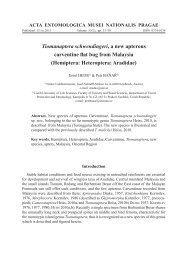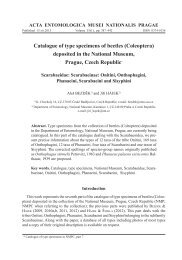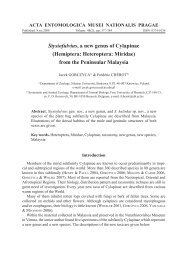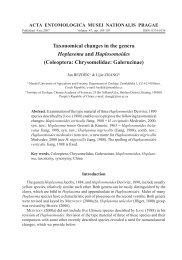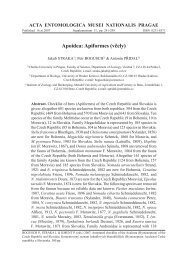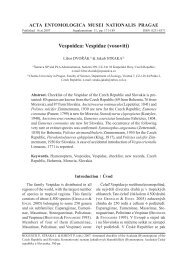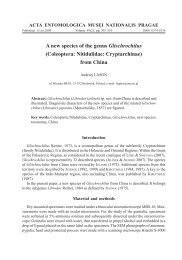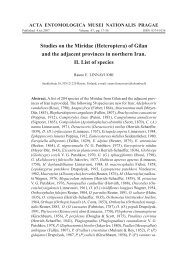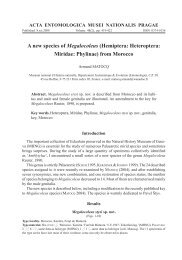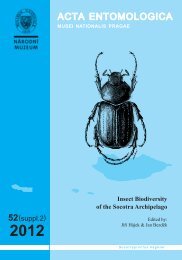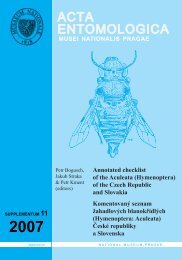Revision of the Palaearctic species of the Coccinella ...
Revision of the Palaearctic species of the Coccinella ...
Revision of the Palaearctic species of the Coccinella ...
Create successful ePaper yourself
Turn your PDF publications into a flip-book with our unique Google optimized e-Paper software.
138<br />
KOVÁŘ: <strong>Coccinella</strong> transversoguttata <strong>species</strong> group and notes on o<strong>the</strong>r <strong>Coccinella</strong><br />
Description. Body robust, shortly oval, in male 1.28 times as long as wide, ra<strong>the</strong>r strongly<br />
convex. Upper surfaces not much shiny, finely and densely punctate, rudimentary pubescent,<br />
setae shorter than diameters <strong>of</strong> punctures.<br />
Head black, eye canthus and large rhombo-pentagonal frontal spot white-yellow. Mouthparts<br />
black, mandible with outer portion <strong>of</strong> base whitish translucent, apex pale brown; tips <strong>of</strong><br />
apical maxillary and labial palpomeres brown. Antenna paler, brown, scape and apical antennomere<br />
strongly infuscate. Pronotum black, antero-lateral corners each with large trapezoidal<br />
white-yellow spot; spots interconnected by narrow white-yellow anterior border suddenly<br />
interrupted in middle. Elytra orange-red, with large elongate rhomboid black scutellar spot<br />
gradually narrowed towards midlength <strong>of</strong> elytra and extended as narrow black sutural line in<br />
posterior half <strong>of</strong> elytra; anterior half <strong>of</strong> elytra with compound black pattern as if composed <strong>of</strong><br />
three confluent spots 1+2+3 on each elytron and widely interconnected with sutural black<br />
marks to form a tricuspidate pattern. Apical half <strong>of</strong> elytron with large oval transverse black<br />
spot, much closer to lateral margin (though not touching it) than to suture. White-yellow<br />
subtriangular mark present at base <strong>of</strong> elytra close to scutellum. Underside black, except for<br />
ra<strong>the</strong>r small whitish area at antero-lateral corners <strong>of</strong> propleura, orange-red elytral epipleura,<br />
white mesepimera and white-ochraceous metepimera. Legs black, anterior face <strong>of</strong> fore coxae<br />
in male with white-ochraceous spot. Ventral face <strong>of</strong> fore femora with pale stripe in male. Most<br />
<strong>of</strong> tarsomeres 3 brown, tarsal claws red-brown.<br />
Head roundly pentagonal, more than 1.33 times as wide as long, 0.51 times as wide as<br />
pronotum. Apex <strong>of</strong> clypeal margin truncate, straight in middle, antero-lateral angle asymmetrical,<br />
sharply triangular, moderately produced forward and only slightly depressed, lateral<br />
sides parallel. Clypeus ra<strong>the</strong>r strongly transversely convex, frontoclypeal sulcus distinctly<br />
marked, widely V-shaped. Frons 0.60 times as wide as head, slightly transverse and convex.<br />
Eyes small, subcircular. Inner orbits slightly and regularly arcuate, subparallel. Long portion<br />
<strong>of</strong> temples behind eyes straight, parallel, <strong>the</strong>n nearly semicircularly narrowing towards occipital<br />
aperture. Surface granulate-reticulate with irregularly dispersed double punctures and<br />
covered with ra<strong>the</strong>r sparse grey-white pubescence. Puncture diameters 0.9-1.2 times (smaller<br />
punctures) or 1.5-1.8 times (larger punctures) as large those <strong>of</strong> eye facets. Smaller punctures<br />
separated usually at most by <strong>the</strong>ir diameter, present at middle <strong>of</strong> frontoclypeus and becoming<br />
distinctly sparser laterally, intermingled with larger ones along clypeal margins, orbits and on<br />
vertex. Setae in middle <strong>of</strong> front rudimentary or missing, along orbits as long as 3-5 diameters<br />
and on clypeal margins as 6-7 diameters <strong>of</strong> eye facet. Antenna as in Fig. 24.<br />
Pronotum pentagonally oval, 1.81 times as wide as long, strongly transverse and convex.<br />
Anterior margin <strong>of</strong> pronotum deeply and ra<strong>the</strong>r narrowly emarginate, emargination trapezoidal,<br />
moderately convex in middle. Anterior corners prominent, <strong>the</strong>ir inner margin flatly and<br />
irregularly S-shaped. Outer margin moderately arcuate, reaching inner one at rectangular,<br />
somewhat asymmetrical tip. Posterior corners slightly obtusangulate, not widely rounded,<br />
situated at posterior 0.4 <strong>of</strong> pronotal length. Distance between anterior and posterior corners<br />
equal to 0.75 <strong>of</strong> pronotal length. Lateral parts <strong>of</strong> pronotal surface as strongly convex as disc,<br />
gradually moderately flattened and slightly depressed towards anterior corners. Lateral margins<br />
widely, towards anterior corners somewhat more strongly arcuate, strongly converging



